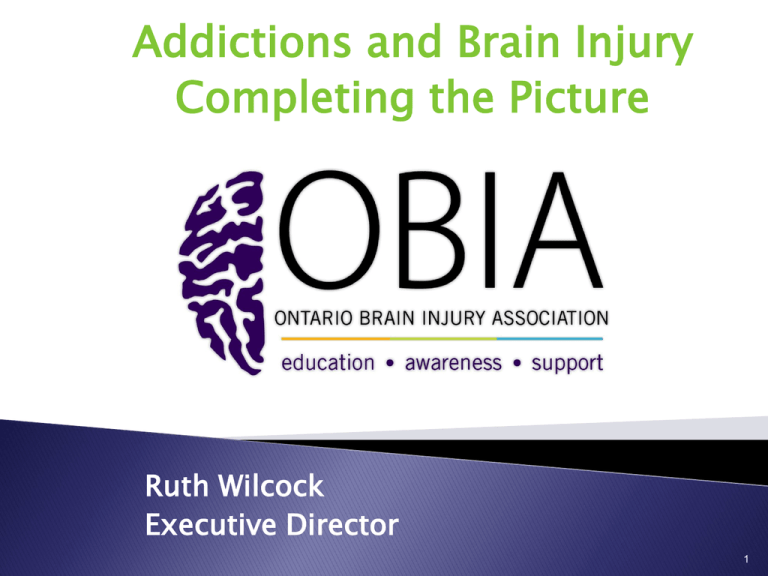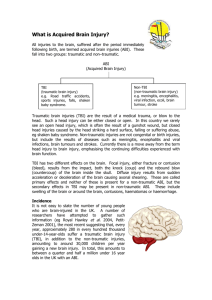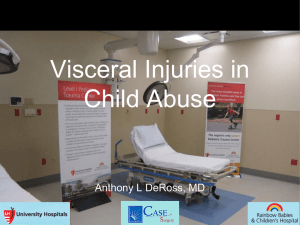- CAST Canada
advertisement

Addictions and Brain Injury Completing the Picture Ruth Wilcock Executive Director 1 To enhance the lives of Ontarians living with the effects of ABI through education, awareness and support 2 6 continuing education courses Over 6000professionals have completed our courses 3 4 1-800-263-5404 5 Income Support Programs ODSP (Ontario Disability Support Program) CPP (Canada Pension Plan) WSIB (Workers Safety Insurance Board) Disability Tax Credits 6 Access to Services Quality of Care and Services General Information 7 21 Affiliated Community Associations across the Province Provide: Information Support Prevention 8 9 10 1. What is Brain Injury 2. Addiction and Substance Abuse 3. Relationship Between Brain Injury and Substance Use/Abuse 4. What You Can Do 11 12 13 14 15 16 17 18 19 Definition: “Damage to the brain that occurs after birth and is not related to a congenital disorder or a degenerative disease such as Cerebral Palsy Alzheimer’s disease or Parkinson’s disease”. A brain injury can occur from: A traumatic event Non traumatic event All brain injuries are traumatic to the person who sustained the injury Trauma is often experienced: Physically Mentally Emotionally There are almost a half a million people living in Ontario with a brain injury 23 24 24 Brain injury is the number one cause of death and disability for Canadians under the age of 45. 25 Cost of ABI The cost of ABI is measured in the hundreds of millions of dollars for medical care, rehabilitation and life long supports. 26 27 Fiction All brain injuries are alike Fact – No two brain injuries are alike Fiction All brain injuries heal with time Fact Many times the damage to the brain is permanent Fiction When one physically recovers the brain has healed itself Fact Person may look fine but cognitive dysfunctions are compromised In many cases the injuries are invisible and the person suffers in silence Undiagnosed Misdiagnosed Misunderstood 53% of homeless people in Toronto have a history of brain injury. Of the 53% of people who have a history of brain injury 70% sustained a brain injury prior to becoming homeless Source: S.W. Hwang, A. Colantonio, S. Chiu, G. Tolomiczenko, A. Kiss, L. Cowan, D.A. Redelmeier, & W. Levinson 33 It is estimated that the prevalence rates for co-morbid psychiatric disorders in ABI may be as high as 44%. 34 US study found that 2% of general population arrested annually 31% of brain injury survivors (5 years post injury)had one or more arrests 35 44% of people in our Ontario prison system have a history of brain injury 86% of prison inmates in New Zealand 87% of county jail inmates in Washington In a sample of 15 convicted murderers sentenced to death, Lewis and colleagues (1986) found that 100% of this death row sample had a history of severe head injury. 36 The brain controls virtually everything humans experience, including: Movement Sensing our environment Regulating our involuntary body processes such as breathing 37 Takes information from other parts of the brain Formulates responses Cognition and memory Ability to concentrate “Gatekeeper” on behaviour (judgment and inhibition) Personality and emotional traits Movement Sense of smell Taste Planning, sequencing and organizing Self-awareness Word formation 41 Any repeated behaviours, substance-related or not, in which a person feels compelled to persist, regardless of its negative impact on her/his life and the lives of others" 42 Compulsive engagement with the behaviour and a preoccupation with it Impaired control over the behaviour Persistence or relapse, despite evidence of harm Dissatisfaction, irritability or intense craving when the object- drug or other activity is not immediately available 43 One-third of ABI survivors have a history of substance abuse prior to their injury One third of incidents that cause brain injury are drug or alcohol related 20% of survivors who do not have a history of substance abuse problem become vulnerable to an abuse problem 44 As much as 43% of people with brain injuries can be classified as moderate to heavy drinkers Substance abuse is reduces immediately following injury but often returns to preinjury levels within two to five years postdischarge Half of people with ABI and substance use problems have parents with substance use problems 45 Alcohol 72% Cannabis 13% Crack and Cocaine 10% Sedatives 2% Heroin 1% Other 2% *Ohio Valley Center for Brain Injury 46 Withdrawal: Physical withdrawal Psychological withdrawal Issues pre-injury not addressed 47 Nearly all addictive drugs, directly or indirectly, target the brain’s reward system by flooding the circuit with dopamine Cocaine reduces dopamine receptors Can take months/years for receptor numbers in the brain to return to pre-drug use figures 48 Alcohol or illicit drugs were used before the injury Drug and alcohol use can develop after a brain injury Tolerance levels of substances are decreased Social groups change 49 Some reasons for substance misuse and abuse can be: A result of chronic pain Cognitive problems Reduced ability to cope with life's new challenges. Impaired insight Lack of self awareness Not understanding the consequences 50 Diminished volume of grey matter Show impaired functions of the pre-frontal cortex 51 Impedes recovery Exacerbates problems with balance, walking and talking Increased disinhibition Interferes with cognitive skills and processing 52 Alcohol increases depression because it is a depressant drug Interaction with prescribed medications Increased risk of another injury *Ohio Valley Center for Brain Injury Prevention and Rehabilitation 53 Service Providers are trained to identify and treat either brain injury or substance abuse, not both Lack of insight by the survivor to the seriousness of the problem Many substance abuse programs do not take clients who are identified as having a brain injury Symptoms of brain injury and substance abuse can present in similar ways and include: 54 Memory problems Difficulty concentrating Balance and co-ordination Impulsivity Mood swings (diminished emotional control) Personality changes Diminished judgement Fatigue Anxiety and or Depression Sleep problems Decreased frustration tolerance 55 Many addiction programs are based on behaviour modification which will not work with a survivor with certain impairments Lack of motivation 56 Have you ever had a concussions? Multiple concussions? (sports related or other) Have you ever been involved in a motor vehicle collisions Have you ever had a stroke? Have you ever had fall and hit your head? Have you ever had a blow to the head? Have you ever had periods of unconsciousness? Have you ever been hospitalized? Be specific. When? How many times? 57 Know what brain injury is and the consequences of brain injury Knowledge and understanding of brain injury will change your approach and how you work with and problem solve with your client who has a brain injury 58 Educate the client early and often about the problems of alcohol and other drugs after brain injury Provide information and support Educate the family about the risks of clients with brain injuries using substances 59 Engage family/social network in actively supporting the client to address the issue. Take a history of client’s prior and current use Ask what effect use is having on client’s life Ask about the social context of use Ask about family’s history of use and/or abuse Help client find meaningful substance-free activities. Establish ongoing contact with professionals in substance abuse programs 60 Stage One – Denial Unaware problem exists No intention of changing Resistant to any type of intervention 61 Stage Two – Contemplation Beginning to become aware Weigh’s pro’s and con’s Still ambivalent 62 Stage Three – Preparing for Change Major turning point Begins to recognize potential losses Reduce amount they are using 63 Stage Four – Action Make significant changes Alter their environment 64 Stage Five – Maintenance Successful at avoiding triggers Has coping skills in place Has a solid support system 65 Make the substance abuse provider aware of: The survivors person's unique communication and learning styles and deficits Known and specific triggers such as over stimulation, fatigue, noise, bright lights Disinhibition problems due to a frontal lobe injury and encourage specific feedback regarding inappropriate behaviour Lack of motivation may be due to cognitive impairments. 66 Referral to treatment settings include: Detoxification programs Residential treatment Intensive Outpatient Care Counselling Self-help groups 12 step programs Psychotherapy Substance Use Brain Injury Bridging Project www.subi.ca 67 Dealing with the client where they are at Reduce risks associated with substance use Increase’s persons sense of control and personal choice Opens up options Move out of a state of chaos into control 68 Assists in dealing with root issues of the addiction Need to embrace the person as a whole including pre-injury 69 70 www.obia.ca 1-800-263-5404 71








